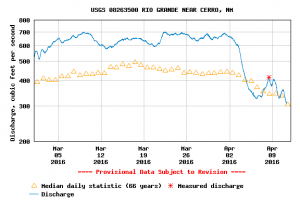Here’s another example of a New Mexico “hydrograph” – the rise and fall of flow on a river over time – driven by rules, not weather. The drop in river flow happens when the irrigation season begins in the San Luis Valley in southern Colorado. Here’s J.R. Logan in the Taos News:
The Río Grande is at the heart of the valley’s massive agricultural industry, and farmers waste no time in taking their share.
“We got to get after it,” says Jay Yeager, head of the Río Grande Canal Water Users Association, which manages a primary irrigation artery in the San Luis Valley.
The rules governing how much Colorado water users can take and how much they must pass downstream for use in New Mexico are governed by the Rio Grande Compact, an agreement among Colorado, New Mexico, and Texas signed in 1938. It is the important implement of governance here, and the flow in the river bears its mark. Here is Logan’s nice explanation of the implications:
The catch – for New Mexico – is that the delivery is calculated on an annual basis, meaning Colorado can let every drop of the river go to New Mexico during the fall and winter while taking most of the river during the spring and summer and still fulfill its debt to New Mexico.
This is a problem if you are a river rafter or a fish, two examples of modern uses and values that weren’t at play in the 1930s when the deal was negotiated.


John,
In your time with the journal did you ever hear any elected officials call for having the compact opened back up for renegotiation?
Matt –
I heard idle chitchat about the idea, but never anything serious. Serious people seem to think opening up the Rio Grande Compact (or any compact) for renegotiation is a bad idea. Too much suddenly up in the air, better to work within the confines….